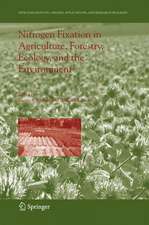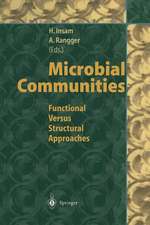Microbiology of Composting
Editat de Heribert Insam, Nuntavun Riddech, Susanne Klammeren Limba Engleză Hardback – 13 mai 2002
| Toate formatele și edițiile | Preț | Express |
|---|---|---|
| Paperback (1) | 1832.22 lei 6-8 săpt. | |
| Springer Berlin, Heidelberg – 30 noi 2010 | 1832.22 lei 6-8 săpt. | |
| Hardback (1) | 1837.12 lei 6-8 săpt. | |
| Springer Berlin, Heidelberg – 13 mai 2002 | 1837.12 lei 6-8 săpt. |
Preț: 1837.12 lei
Preț vechi: 2240.40 lei
-18% Nou
Puncte Express: 2756
Preț estimativ în valută:
351.52€ • 367.02$ • 290.94£
351.52€ • 367.02$ • 290.94£
Carte tipărită la comandă
Livrare economică 04-18 aprilie
Preluare comenzi: 021 569.72.76
Specificații
ISBN-13: 9783540675686
ISBN-10: 354067568X
Pagini: 648
Ilustrații: XII, 636 p.
Dimensiuni: 155 x 235 x 40 mm
Greutate: 1.03 kg
Ediția:2002
Editura: Springer Berlin, Heidelberg
Colecția Springer
Locul publicării:Berlin, Heidelberg, Germany
ISBN-10: 354067568X
Pagini: 648
Ilustrații: XII, 636 p.
Dimensiuni: 155 x 235 x 40 mm
Greutate: 1.03 kg
Ediția:2002
Editura: Springer Berlin, Heidelberg
Colecția Springer
Locul publicării:Berlin, Heidelberg, Germany
Public țintă
ResearchDescriere
Composting is increasingly used as a recycling technology for organic wastes. Knowledge on the composition and activities of compost microbial communities has so far been based on traditional methods. New molecular and physiological tools now offer new insights into the "black box" of decaying material. An unforeseen diversity of microorganisms are involved in composting, opening up an enormous potential for future process and product improvements. In this book, the views of scientists, engineers and end-users on compost production, process optimisation, standardisation and product application are presented.
Cuprins
Microbial Communities.- How Resilient Are Microbial Communities to Temperature Changes During Composting?.- Survey of Fungal Diversity in Mushroom Compost Using Sequences of PCR-Amplified Genes Encoding 18S Ribosomal RNA.- Bacterial Community Structure During Yard Trimmings Composting.- Characterisation of Microbial Communities During Composting of Organic Wastes.- Microbial Succession During Composting of Source-Separated Urban Organic Household Waste Under Different Initial Temperature Conditions.- Bacterial Diversity in Livestock Manure Composts as Characterized by Terminal Restriction Fragment Length Polymorphisms (T-RLFP) of PCR-amplified 16S rRNA Gene Sequences.- Amplified 16S Ribosomal DNA Restriction Analysis of Microbial Community Structure During Rapid Degradation of a Biopolymer, PHA, by Composting.- Comparative Investigation of Vermicompost Microbial Communities.- Processes and Controls.- Heat Production During Thermophilic Decomposition of Municipal Wastes in the Dano-System Composting Plant.- Composting of Different Horticultural Wastes: Effect of Fungal Inoculation.- Backyard Composting: General Considerations and a Case Study.- N-Dynamics During Composting — Overview and Experimental Results.- Unsuitability of Anaerobic Compost from Solid Substrate Anaerobic Digestion as a Soil Amendment.- Pile Composting of Two-phase Centrifuged Olive Husks: Bioindicators of the Process.- Organic Acids as a Decisive Limitation to Process Dynamics During Composting of Organic Matter.- Effects of Interrupted Air Supply on the Composting Process — Composition of Volatile Organic Acids.- Reduction of Ammonia Emission and Waste Gas Volume by Composting at Low Oxygen Pressure.- Review of Compost Process-Control for Product Function.- Using Agricultural Wastes for Tricholoma crassum (Berk.) Sacc. Production.- Microbial Transformation of Nitrogen During Composting.- Effect of Additives on the Nitrification-Denitrification Activities During Composting of Chicken Manure.- Biodegradability.- Biodegradability Study on Films for Packaging Based on Isotactic Polypropylene Modified with Natural Terpene Resins.- Isolation and Characterization of Thermophilic Microorganisms Able to Grow on Cellulose Acetate.- PCB’s Biotransformation by a White-Rot Fungus Under Composting and Liquid Culture Conditions.- Tests on Composting of Degradable Polyethylene in Respect to the Quality of the End-Product Compost.- Microbial Degradation of Sulfonylurea Herbicides:Chlorsulfuron and Metsulfuron-Methyl.- Maturity Testing.- Hydrogen Peroxide Effects on Composting and Its Use in Assessing the Degree of Maturity.- Plant Performance in Relation to Oxygen Depletion, CO2-Rate and Volatile Organic Acids in Container Media Composts of Varying Maturity.- Microbiological and Chemical Characterisation of Composts at Different Levels of Maturity, with Evaluation of Phytotoxicity and Enzymatic Activities.- Monitoring of a Composting Process: Thermal Stability of Raw Materials and Products.- Compost Maturity — Problems Associated with Testing.- Use of CLPP for Evaluating the Role of Different Organic Materials in Composting.- Evaluation of Organic Matter Stability During the Composting Process of Agroindustrial Wastes.- Characterization of Organic Substances in Stabilized Composts of Rest Wastes.- Application and Environmental Impact.- Composting of Posidonia oceanica and Its Use in Agriculture.- Practical Use of Quality Compost for Plant Health and Vitality Improvement.- Environmental Impacts of Cattle Manure Composting.- Agronomic Value and Environmental Impacts of Urban Composts Used in Agriculture.- Composting in the Framework of the EU Landfill Directive.- Occurence of Aspergillus fumigatus in a Compost Polluted with Heavy Metals.- Important Aspects of Biowaste Collection and Composting in Nigeria.- Plant and Human Pathogens.- Use of Actinobacteria in Composting of Sheep Litter.- Methods for Health Risk Assessment by Clostridium botulinum in Biocompost.- The Fate of Plant Pathogens and Seeds During Backyard Composting of Vegetable, Fruit and Garden Waste.- Survival of Phytopathogen Viruses During Semipilot-Scale Composting.- Air-Borne Emissions and Their Control.- Composting Conditions Preventing the Development of Odorous Compounds.- Odour Emissions During Yard Waste Composting: Effect of Turning Frequency.- Imission of Microorganisms from Composting Facilities.- Molecular Identification of Airborne Microorganisms from Composting Facilities.- Bioaerosols and Public Health.- Passively Aerated Composting of Straw-Rich Organic Pig Manure.
Caracteristici
Composting - an increasingly important method for waste reduction and treatment
Includes supplementary material: sn.pub/extras
Includes supplementary material: sn.pub/extras





















